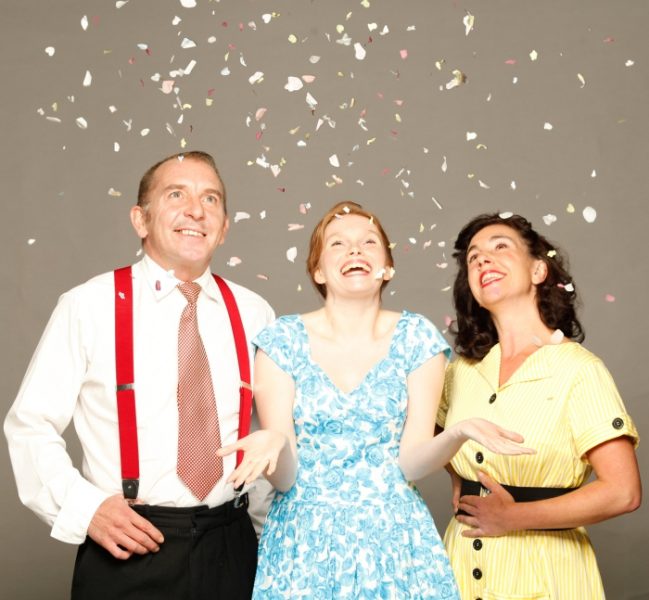Showing @ venues across Scotland
Emma Hay talks to actress Nicola Jo Cully about Nutshell Theatre’s site-specific piece Thread, dealing with dementia, sexuality and the long-gone 50s.
Tell us a bit about Thread and your character, Joan…
Thread is a play set in Burntisland, Fife, at a beetle drive. It goes from 50s right through to now telling the story of Joan, Izzy and William. They’re all friends, they’ve grown up together, gone to the beach together. William asks Joan out, they end up married. They can’t have children and that does have an effect on the relationship, but they’re happy. You find out later in the show that Joan and Izzy were once lovers – so this is ultimately a play about love and 3 characters that love each other. Joan has dementia and Izzy tries to help Will deal with that. He always knew about Izzy and Joan together and just never s spoke about it. It just shows you’ll do anything for the person you love.
The tagline for the show is ‘who becomes the person they want to be?’ – set in the 50s in a small community, do you think it’s easier now for people to be who they want to be?
I think so, yes. In Burntisland in the 50s, you’d have been expected to leave school and get a job. They didn’t really go to University or move away – that was especially true for women. If you wanted to go to further afield, you needed money. Nowadays, whether you’re a man or woman, you want that independence. With sexuality too, things are a lot more open now and people should be able to be gay, straight, bisexual, whatever they want to be. There are a lot more options for people. Social media has probably played a part in that too – you can connect with anyone anywhere in the world – that was a lot more difficult 60 years ago.
The play is very reflective of the 50s. What do you think we could learn from the way people were back then?
I think so, people were certainly a lot more neighbourly. I know one of my neighbours, maybe the name of some, but nothing more. Community spirit was a lot bigger then – you’d go to the dance or to the local hall. We don’t really first foot any more, we can’t lock our doors any more. This day and age isn’t as personal; Skype, text, it’s not the same as meeting face to face. The community spirit and interaction – we could definitely learn from what’s there on our doorstep.
This is a site-specific piece. What do you think the audience get from site-specific which they might not from a more traditional space?
If people aren’t theatre goers, they might feel awkward sitting in a traditional space. Site specific work can be taken to communities and theatres that might not have it – especially this show. There’s maybe only 55 people in the audience, but it’s intimate. In a traditional theatre, you might not get that. We got such a welcome at the show last night – they had wine and tea and coffee – they made us soup. Performances don’t have to be limited to a theatre – you can perform anywhere.
In what ways, if any does the creative process change because its site specific?
Projecting your voice, you need to do that a lot more in the theatre. Site specific work can be more intimate, more emotional things can be done delicately. With Thread, it can be a lot more naturalistic to act. But at the same time, you’re limited with space. You’d have to adapt set, and with touring it needs to be minimal. But if it’s outdoor site specific, you can have anything you want. You have to take into account the world around you – buses or fire engines racing by, you have to work against the elements.
The Still Points of the Turning World trilogy – (of which Thread is the second) – consider the effects had on us by the dramas of every day life – why do you think that doing this is important?
Because everyone had a childhood, and everyone grows up. My Grandfather had dementia – a lot of people have seen it, have family members with it too – it’s life and it happens and people connect to that. The beetle drive in the show, most of the time people are sitting with strangers. You play with someone you don’t know and then come out at the show and talk to someone – you can engage with other people as well as the show.
The play was inspired by a sewing box that the director, Kate Nelson, found in a shop in Edinburgh. Is there anything you have, or have discovered that you’ve really wanted to make a piece of theatre about?
I have a lot of things from my Grandparents, a lot of old photographs. I think the thing about photos is that they say so much and ask so many questions at the same time: when was it taken, where was it taken, who took the photo, what was the connection between the person and the place? When my Great-Great-Auntie passed away, we found a photo of a woman, probably taken in the 1900s, on cardboard. It’s brown and white, of a lady in what is most likely a wedding dress behind a chair. We have no idea who she is – there are ideas of who we think she might be, but we don’t know for sure. What I always think is that my Great-Great-Auntie must have kept that photo for a reason. There’s no expression on her face so you have no idea what she’s thinking. It’s the most amazing photo, so I’m so glad I have it.
Click here for more information about Thread and Nutshell Theatre.
Follow Emma on Twitter @emmalhay

